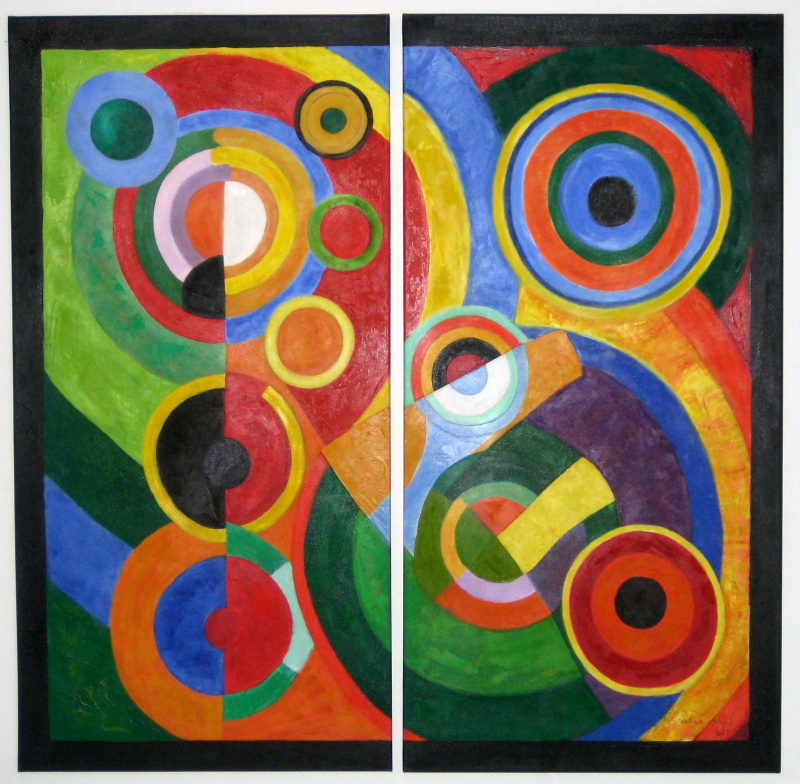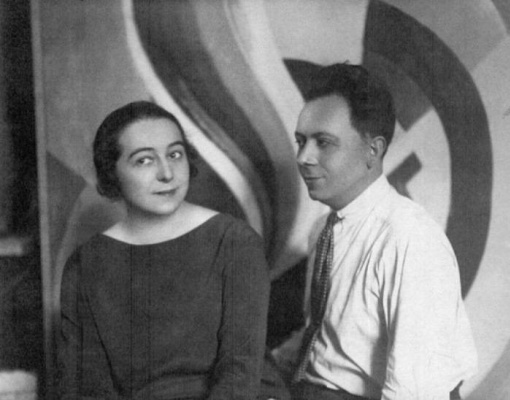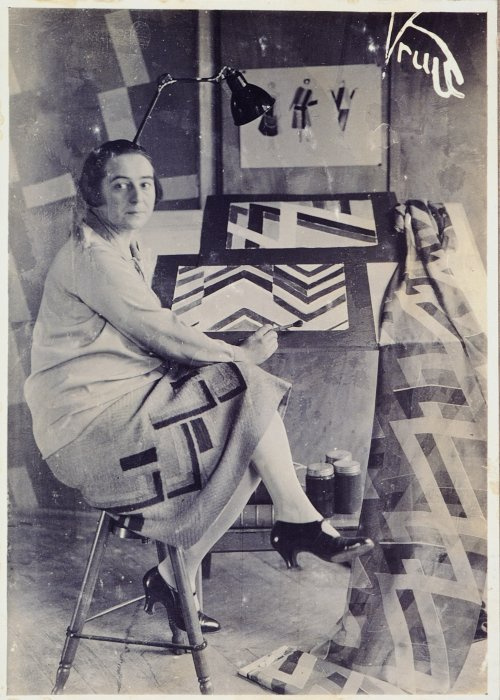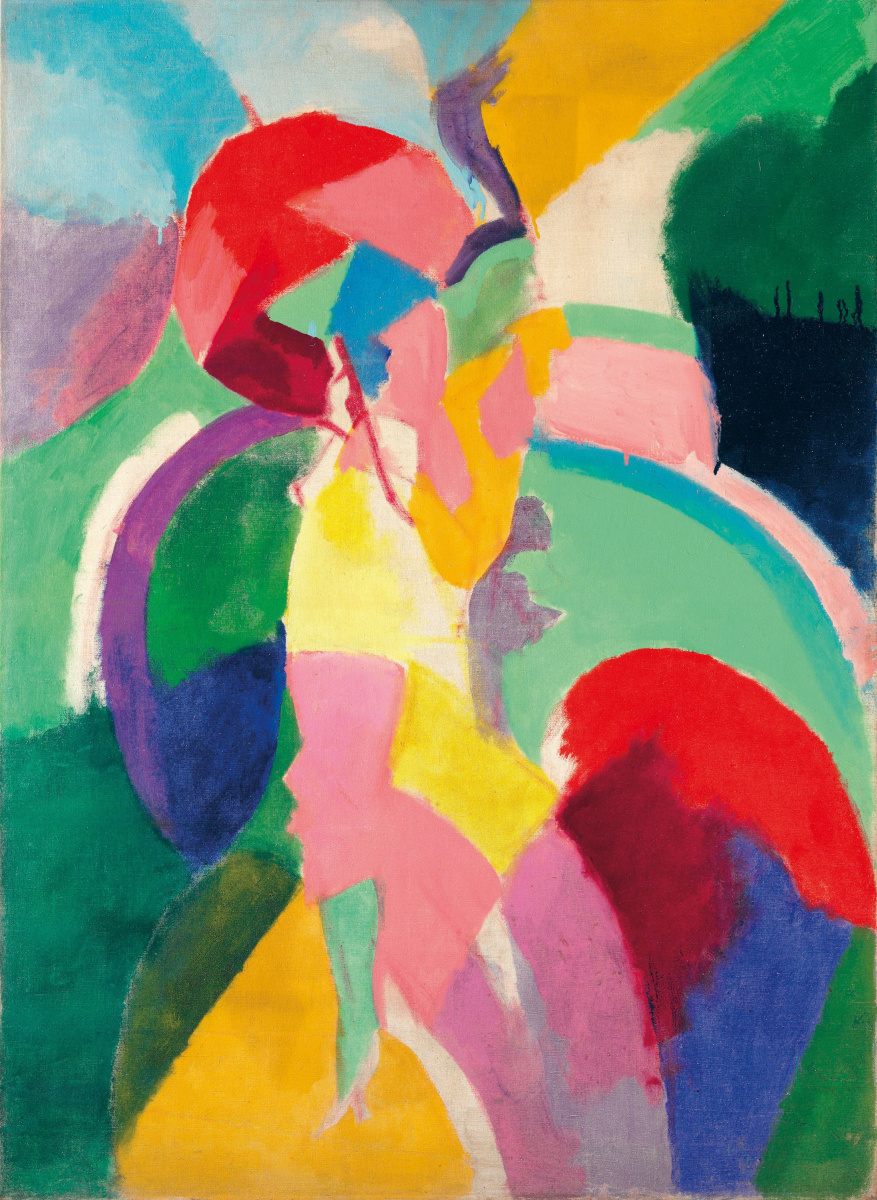Orphism was invented by Robert Delaunay, because he felt too tight within Cubism. The opportunity to experiment with shape fascinated Delaunay much less than playing with light and colour. Orphism is characterized by concentric circles and discs of contrasting colours that create a sense of movement and rhythm. Orphist paintings are either painted on a plane, or represent an intersection of different planes.

Singer flamenco
1916
Orphism became one of the first movements of abstract painting. Certainly, avoiding figurativeness was not invented by Delaunay. Although it was he who declared the subject a secondary matter. The main thing was colour and light. Technically, they realised it most often through concentric colour circles filled with light and gave the viewer the feeling of seeing the picture from many positions at the same time.
For the first time, Orphist paintings were presented to the public in 1913 at the Salon of the Independent, and they also participated in the Blue Rider exhibitions.
For the first time, Orphist paintings were presented to the public in 1913 at the Salon of the Independent, and they also participated in the Blue Rider exhibitions.
Relatives of Orphism, or How to distinguish Orphist paintings
The greatest influence on the creation of Orphism was exerted by Georges Seurat, he was the first to decompose colour into its constituent points. But, unlike the Pointillists, the Orphists used the Cubist scheme — to disassemble something into its original components and combine in an order dictated by their own inspiration, and not "as it was". The Orphists did this not to shape, but to light, they decomposed it into shades of the spectrum and connected the shades in a contrasting order.Orphism is related to Cubism by shape and abstraction, but it is significantly distinguished by the richness of the palette. For an Orphist, colour is the main thing!
Even the Fauves, well-known connoisseurs of colour, did not dare to proclaim it more important than the plot. But they shared the brightness of the colours with the new direction. The strength of the emotional impact carries a trace of expressionism, the brushstroke in some works is clearly impressionistic. But Orphism is not a subject, its images can carry elements of figurativeness, but in general they are not figurative, in contrast to the above styles.
The woman with the umbrella. (Parisienne)
1913, 122×90 cm
From the futurists, the Orphists took love for cars and dynamism. But among the Orphists, the internal dynamics of the image arose when contrasting colours were compared, and not as a result of introducing movement itself into the image.
Homage to Blériot
1914, 250×251 cm
Simultanism vs Orphism
In 1912, Robert Delaunay’s On Light manifesto was published, in which the main provisions of not Orphism, but Simultanism (from the Latin simul — together, simultaneously) were declared. The founder gave this name to his "brainchild". Affected by for the labours of the chemist Eugène Chevreul, who headed the Tapestry Manufactory, Robert Delaunay adopted his principle of simultaneous contrasts, which suggests our perception to require placing contrasting colours next to those we contemplate.
Spouses Robert and Sonia Delaunay, the founders of Orphism.
"Cosmic upheavals, the desire for purification… Nothing horizontal or vertical — the light deforms and breaks everything …" (from Robert Delaunay’s On Light manifesto).
The name Orphism was invented by the poet Guillaume Apollinaire, with a reference to the ancient Greek musician Orpheus. According to Apollinaire, the effect of Simultanist paintings on the viewer is comparable to the effect of Orpheus’s music. By the way, Robert Delaunay himself did not like the name Orphism much, but thanks to Apollinaire it stuck and is used more actively than the original one. Moreover, it also reflects such parameters of Simultanist paintings as musicality and rhythm.
Orphist call to Russia
Georgy Yakulov made a lot of efforts in 1913 to bring the paintings of the Delaunay spouses to an exhibition in Moscow, and he finally succeeded. At the same time, Yakulov himself invented his own style, the "theory of suns", close to the Simultanism that deeply impressed him.It is interesting to compare the Delaunay spouses with another pair of artists who lived in Russia during these years and, in parallel with the Orphists, announced their new artistic trend, Rayonism, which became a harbinger of non-objectivity in Russia. Mikhail Larionov and Natalia Goncharova depicted rays reflected from objects. But unlike their Russian "colleagues", for whom Rayonism
became only one of their creative stages, Sonia and Robert Delaunay actively used Orphism techniques throughout their lives, although Orphism existed as an active movement until 1915—1916.
Orphism: a Crib
Artists who painted in the style of Orphism or something close to it: Robert Delaunay, Sonia Delaunay, František Kupka, Fernand Leger, Francis Picabia, Aristarkh Lentulov, Wladimir Baranoff-Rossine, Morgan Russell.Francis Picabia. Light
Picabia portrayed the main "hero" of the Orphists — light.
Significant Orphist paintings:
Robert Delaunay. Simultaneously Open Windows, 1912. At the exhibition of the Salon of the Independent in 1913, Robert Delaunay showed a series of "windows", which outlined the priorities of the new direction: colour, contrasts, light refraction. Each colour is represented by a separate plane, the space of the picture consists of airy, shining colour planes layering on each other.
Robert Delaunay. Simultaneously Open Windows, 1912. At the exhibition of the Salon of the Independent in 1913, Robert Delaunay showed a series of "windows", which outlined the priorities of the new direction: colour, contrasts, light refraction. Each colour is represented by a separate plane, the space of the picture consists of airy, shining colour planes layering on each other.
Simultaneous Windows (Simultaneously open Windows)
1912, 55×46 cm
Sonia Delaunay Market at Minho, 1915. This painting was bought by an unknown admirer of Orphism (rumoured to be a Russian) at the Parisian Calmels Cohen auction in 2002 for 4.59 million euros. Vivid, bright, colourful. It has elements of figurativeness, it is not a pure abstraction, but at the same time it is typically Orphist: bright, colourful circles, a sense of sound, rhythm, active use of the Orphists' favourite contrast — red and blue.
Market at Minho
1915, 127.5×92.5 cm
You are an expert if:
You think that Orphist paintings are a madness of colour and light, radiance and brightness, built on contrasts and create an illusion of sound and movement. And they even look like a kaleidoscope pattern. They really do!
You are a layman if:
You think that Orphism is bright unclear circles. Orphist paintings may well be objective, as it has already been said, and they are not just circles. Yet Orphism is not Cubism , its main matter is light and colour, not shape.
You think that Orphist paintings are a madness of colour and light, radiance and brightness, built on contrasts and create an illusion of sound and movement. And they even look like a kaleidoscope pattern. They really do!
You are a layman if:
You think that Orphism is bright unclear circles. Orphist paintings may well be objective, as it has already been said, and they are not just circles. Yet Orphism is not Cubism , its main matter is light and colour, not shape.

What a story!
Initially, the Orphists did paint circles or discs. But later Sonia Delaunay was carried away by the works of Piet Mondrian, and preferred squares and corners: "I noticed Mondrian’s paintings because I liked squares. I started using squares. And Robert continued to draw circles." At the same time, she retained fidelity to simultaneous contrasts.
The title illustration: Rhythm (1912), the abstract Orphist painting by the founder of the movement, Robert Delaunay. It reflects the main components of Orphism: bright contrasting combinations of colours, adjusting light, concentric circles and the rhythm of the image, which cannot be ignored even by the worst ignorants because of the title of the picture.
Author: Aliona Esaulova
Author: Aliona Esaulova






















